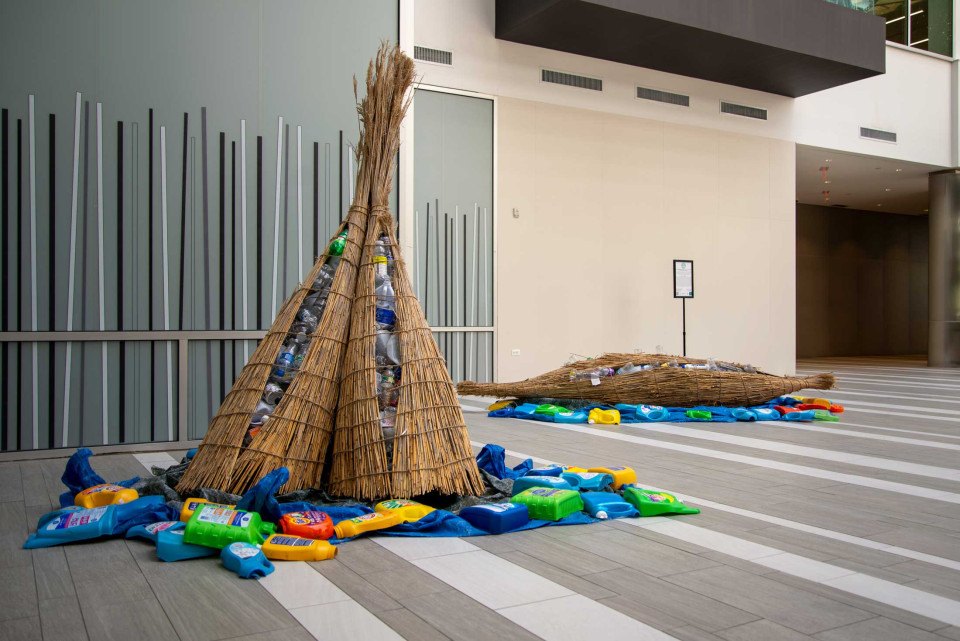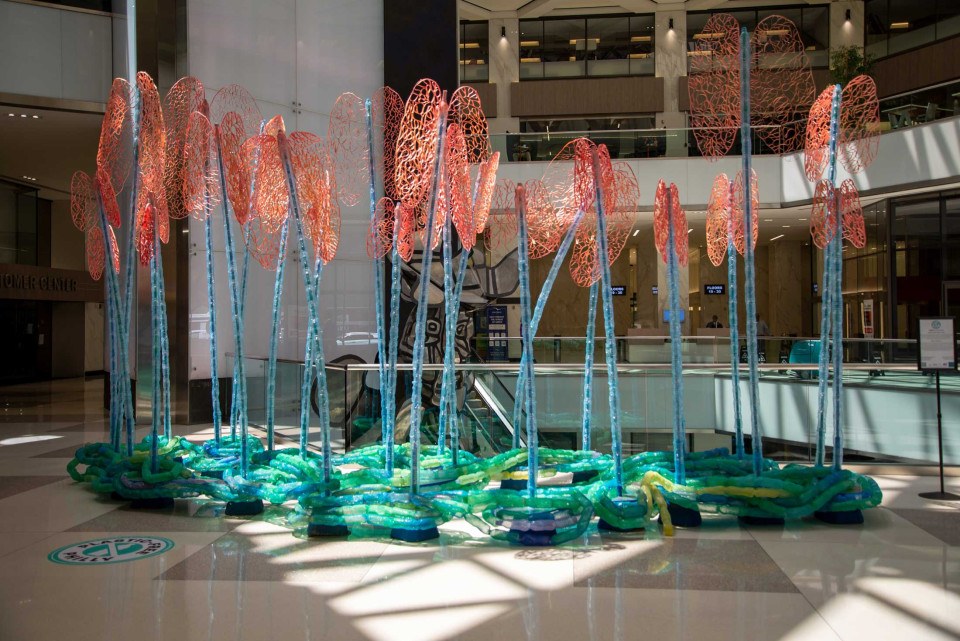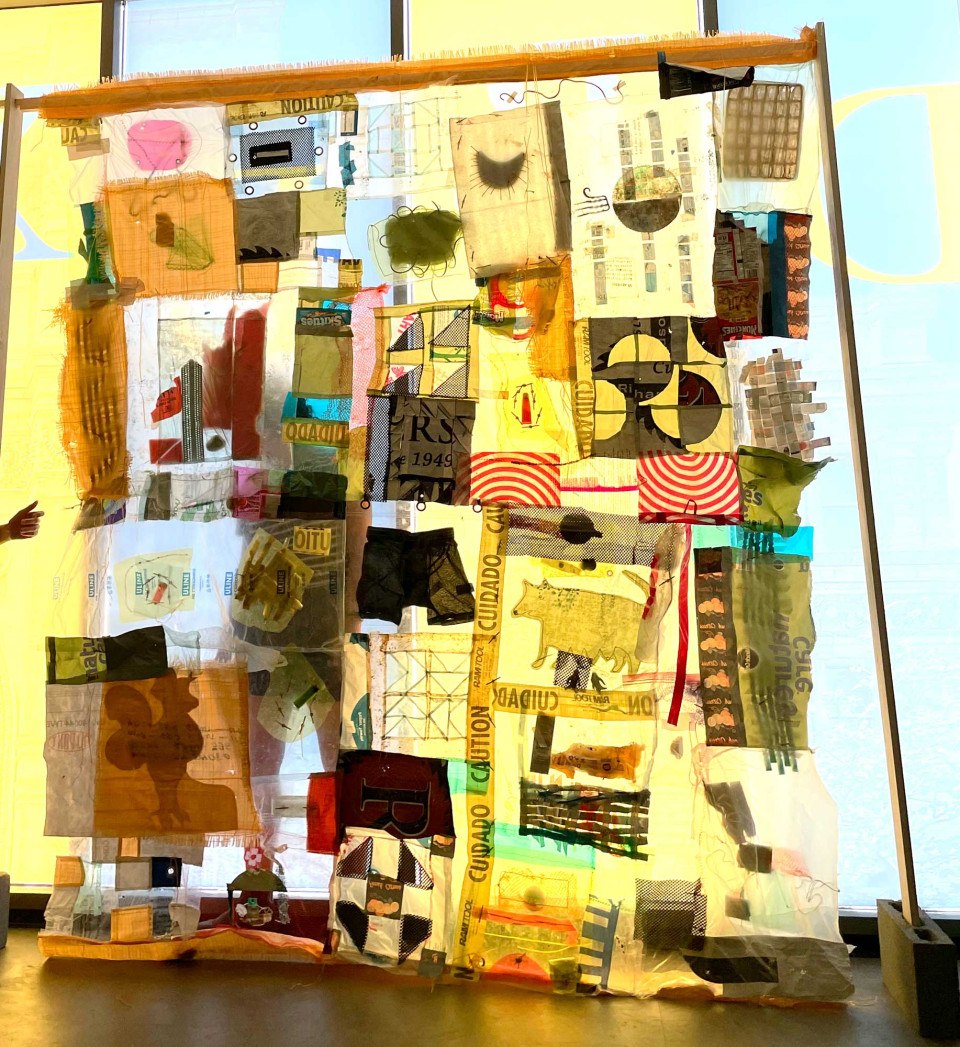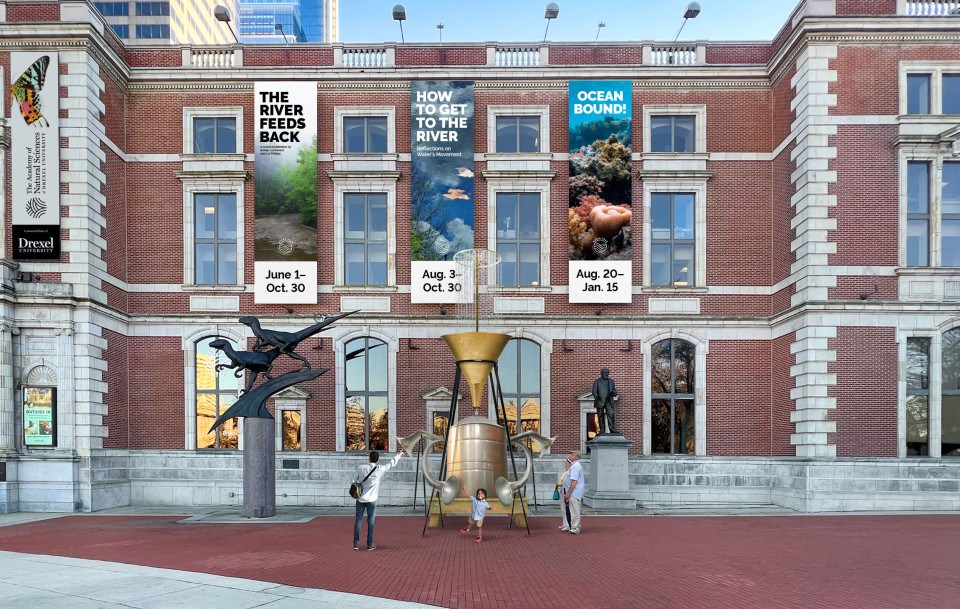The Academy of Natural Sciences Seeks to Save Our Rivers With Art
Soundscapes, sculptures made from recycled plastic, an adventure walk and more. Here's where and when to find them.

That Sinking Feeling by Aymar Ccopacatty, at 1900 Market Street / Photograph by Ramon Torres for the Academy of Natural Sciences
Public art can transform — a wall, a block, an abandoned lot. And this summer, the Academy of Natural Sciences is hoping that public art can help transform the environment. Part of the institution’s Water Year initiative to connect people with their local waterways to inspire awareness and action to protect them, these 10 installations are currently on view in lobbies throughout Center City and University City — with more to come later this summer. Here’s more about the art installations — and when and where you can find them.
Plastic-Free Philly
Through July 30
Plastic litter makes up more than half of the trash removed from the Schuylkill and Delaware rivers in Philadelphia in a single year, and much of that waste is due to single-use bottles. So, the Academy teamed up with the Philadelphia Water Department, BOMA Philadelphia and 10 local artists to create temporary installations in lobbies throughout Center City and University City. The installations evoke the natural features of the watershed while communicating the dangers that come with the use and disposal of consumer plastic, and encouraging viewers to be more mindful of their impact on the environment.
“Plastics in our waterways are harmful in many ways to people, fish and animals,” says Roland Wall, director of the Academy’s Patrick Center for Environmental Research, which has studied the interactions of people and the environment for nearly 80 years. “Plastic slowly breaks down into tiny pieces which are often ingested by fish and other wildlife, putting them at risk for choking and suffocation. These micro-plastics pollute the earth, and their effects travel through the food web, harming human health.”

Forest by Kate Dodd, at 1500 Market Street, is just one of the art installations made of post-consumer plastic, designed to inspire awareness and conservation of the river and watershed. / Photograph by Ramon Torres for the Academy of Natural Sciences
Some pieces, like Waterline by Silas McDonough and Forest by Kate Dodd, are made of recycled and post-consumer plastic, sculpted into something new. In others, like Fountain of Life by Emilio Maldonado and Plastic Waterfall by Sarah Peoples, the single-use plastic vessels are more intact and identifiable.
“I’m using age-old tropes of irony and satire to get these ideas across, and, in this case, help us recognize our personal habits,” Peoples says. “And so, this plastic waterfall is fun and has a sense of humor, and it’s easy to look at, and it’s pretty, but ultimately it’s a cautionary tale.”

Waterline by Silas McDonough, at The Academy of Natural Sciences / Photograph by Laura Swartz
Meanwhile, artist Ben Peterson has been continuously crafting 156 bottles from clay on potter’s wheels in the lobby of Three Logan Square. Why 156? Because that’s the number of single-use plastic water bottles the average American buys in one year. You can catch him at 1717 Arch Street from 11 a.m. to 1 p.m. on Thursdays through July 28th.
One piece will remain on display through September 30th: the Schuylkill River Trash Quilt by Celia Jailer, Eli Kleinsmith and Pierie Korostoff. Made of trash that the artists collected from the Schuylkill River, cleaned and stitched together, the quilt is currently on display at Drexel University’s MacAlister Hall (3250 Chestnut Street).

Schuylkill River Trash Quilt by Celia Jailer, Eli Kleinsmith and Pierie Korostof at MacAlister Hall, Drexel University, 3250 Chestnut Street, through September 30th / Photograph by Ramon Torres for the Academy of Natural Sciences
Here is where you can find all 10 pieces:

Watershed Moment
August 3rd-October 30th
Next up is a four-part multi-faceted project featuring art and sound installations (and an outdoor adventure walk!) inspired by the lower Schuylkill watershed.
“Contemplating watersheds sets in motion a wonderful set of connections that tie us to the places where we live — bioregions with unique ecologies defined by the presence or relative absence of water,” Academy vice president of experience and engagement Marina McDougall explains. “Here in Philadelphia, we inhabit the riparian landscapes of the great Delaware River Watershed and the smaller watersheds that nest within the basin. Watershed Moment is a series of mind-altering experiences based in watershed thinking.”

The River Feeds Back sound installation, currently on display at the Academy of Natural Sciences / Photograph by Ramon Torres for the Academy of Natural Sciences
Though the project officially begins on August 3rd, you can already see one part of it inside the Academy: The River Feeds Back, a sound installation created by artists Annea Lockwood and Liz Phillips, using sounds recorded at sites along the 135 miles of the Schuylkill River played through portals made of wood, slate and clay pottery. Walk into the museum’s Dietrich Gallery, and you’re transported to the river with sounds of rushing water, croaking frogs and other wildlife.
It’s a companion piece to Inside the Watershed, another sound installation that you’ll be able to find on the Schuylkill River Trail.

Attunement, designed by David Gordon, fabricated by Jordan Griska, produced by New Paradise Laboratories / Rendering courtesy of the Academy of Natural Sciences
You’ll find another soundscape outside the museum — the 35-foot-tall Attunement. The large-scale sound sculpture is constructed largely of recycled materials including a giant funnel, agricultural cistern and sousaphone bells; and uses irrigation technologies to create a “sonic translation” of the water cycle.
And finally, the outdoor adventure walk, How to Get to the River, is a 1.5-mile trip from the museum down Cherry Street to the Schuylkill River (and back) with sidewalk art, musical interludes, immersive sound experiences, creative signage, sculpture, maps, lenticular imagery, playful interactions, and more along the way. Participants can activate sound elements with a digital fob, and learn about urban water flow at each activation. Each walk can have a maximum of four participants; and timed tickets are required. The experience is free with Academy general admission, or you can purchase a standalone ticket for $7.


